3 History of Rockets & Space Flight
Introduction
Since antiquity, humans have dreamed of climbing onto the top of a towering rocket to fly themselves out of the Earth’s atmosphere and upward into space, first to the Moon and then beyond. However, rockets and powerful enough engines have only been developed in the last half-century to allow artificial satellites and humans to reach space.
In the 1920s, the development of rudimentary rocket engines for propulsion opened up new opportunities for scientists and engineers to advance into the field of spaceflight. In the 1950s and 1960s, there were rapid developments in the design of rocket engines and reliable launch vehicles, allowing satellites and humans to finally reach orbit. Since then, humans have traveled into space, walked on the surface of the Moon, launched thousands of satellites (many of which have gone into deep space), and operated orbiting space stations. Humans will likely return to the Moon in this decade, colonize Mars within another decade, and reach other planets in the solar system within another two decades.
The engineering and other challenges of reaching space[1] should never be underestimated. First, overcoming Earth’s gravity to reach space requires a velocity of at least 11.2 kilometers per second (25,020 miles per hour). Then, when reaching space, it becomes an incredibly harsh environment for humans – a vacuum with no air, severe temperatures ranging from extreme cold to extreme heat, harmful radiation, and other hazards. Distances are vast. The solar system’s edge, known as the heliopause, is approximately 18 billion kilometers (11 billion miles) from the Sun. The nearest star system to the solar system, Alpha Centauri, is approximately 4.37 light-years away, roughly 41 trillion kilometers (25.5 trillion miles).
The vastness of space and the universe as a whole is best summed up by a quote from the extraordinary scientist, astronomer, and professor Dr. Carl Sagan: “Even these stars, which seem so numerous, are as sand, as dust, or less than dust, in the enormity of the space in which there is nothing.” The recent photograph of the Earth taken from the Orion spacecraft, as shown below, eminently makes the point. All of what we are and what we know is just a speck of dust in the universe, and our existence has been just a momentary blip in the Brief History of Time.
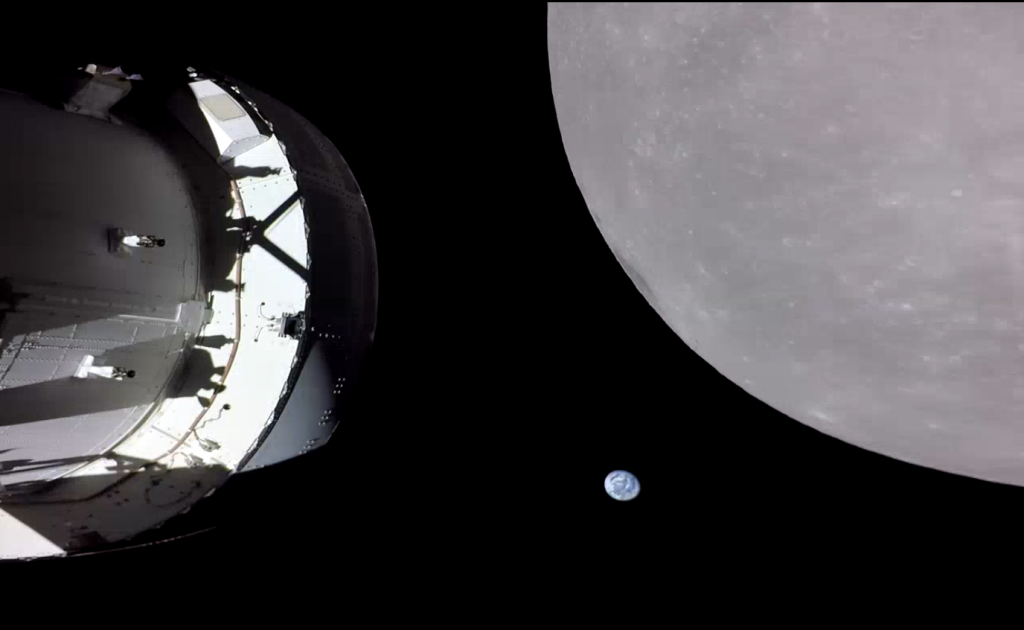
Learning Objectives
- Appreciate the historical evolution of rockets, launch vehicles, and different spacecraft designs.
- Identify some key challenges and technological advancements in the history of astronautics.
- Understand the basic principles of launching a rocket, including multi-stage rockets.
- Consider where continued advances in spaceflight technology might take humankind in another half-century.
The Quest for Space
Rockets were invented in China during the Tang dynasty (618–907 AD), specifically in the 9th century, shortly after the discovery of gunpowder. They were called “fire arrows” and were first employed as fireworks and weapons of war. They consisted of a simple tube filled with gunpowder and attached to a shaft with feathers resembling an arrow. When ignited, the expanding gases from the burning gunpowder were expelled out of the rear of the tube, creating thrust and propelling the arrow forward. These fire arrows and similar rocket-based weaponry spread from China to Japan and other parts of Asia, and eventually to the Middle East and Europe.
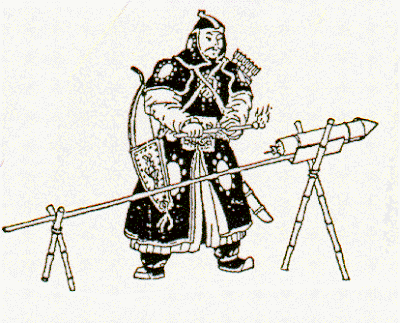
In his science fiction novels from the 1860s, the novelist Jules Verne imagined rockets leaving Earth and landing on the moon, his books popularizing widespread interest in science and the potential for spaceflight. While Verne’s novels were groundbreaking and sparked much public interest in space travel, they also reflected the limited scientific knowledge in the 19th century. The concept of using a cannon to launch a spacecraft to the Moon was based more on creative storytelling than scientific feasibility. Nonetheless, Jules Verne’s contributions to science fiction inspired generations of future scientists and engineers with his imaginative tales of space travel.
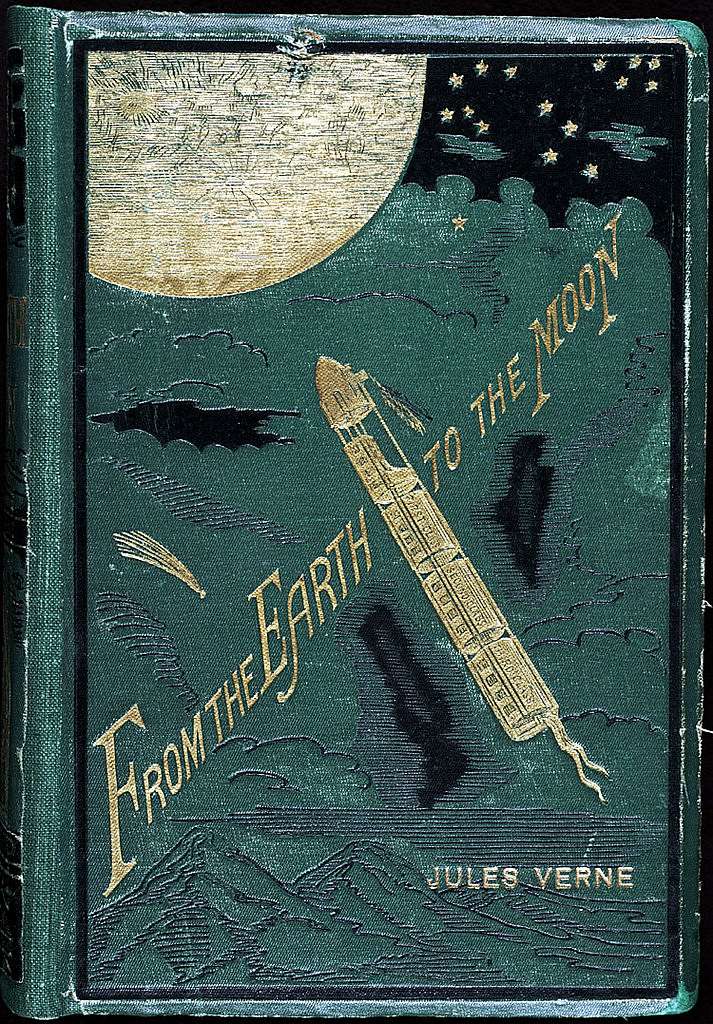
A challenge in reaching the higher atmosphere and then space is that rocket engines must be designed to operate in a vacuum without any oxygen; therefore, the spacecraft they power must carry fuel and an oxidizer, which together form a propellant. In 1903 in Russia, Konstantin Tsiolkovsky published a technical paper (in Russian) about rocket flight titled “The Exploration of Cosmic Space by Means of Reaction Devices.” See also: “Study of Outer Space by Reaction Devices,” NASA TT F-15571. In 1929, he also proposed the concept of multistage rockets and suggested the possibilities of space travel. Tsiolkovsky’s visionary ideas and dedication to space exploration profoundly impacted the development of rocket technology, laying the groundwork for the eventual human exploration of space.
In the U.S., Robert Goddard received two patents in 1914. One was for a rocket using liquid fuel (Patent US1103503A), as illustrated in the figure below, and the other was for two-stage or three-stage rockets (Patent US1102653A) that utilized solid propellant. In 1919, he published a technical paper titled “A Method of Reaching Extreme Altitudes.” This paper influenced many working in rocketry, including Hermann Oberth and a young Wernher Von Braun, who was later to be part of NASA’s ballistic missile, rocket, and spaceflight programs.
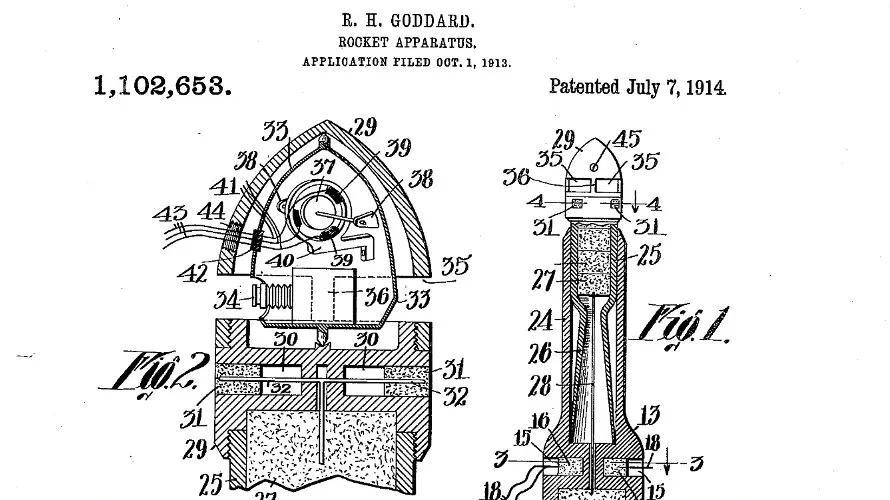
Goddard tested rocket engines in a vacuum chamber and built and flew the first successful liquid-propellant rocket engine in 1926. By the mid-1930s, his rockets were flying at supersonic speeds and reaching heights of nearly two miles (3.2 km). Goddard’s achievements in rocket propulsion significantly advanced the technical field of rocketry, and his theoretical and practical work laid down the foundations for the scientific exploration of space. For this reason, Robert Goddard is often referred to as the “Father of Rocket Propulsion.”
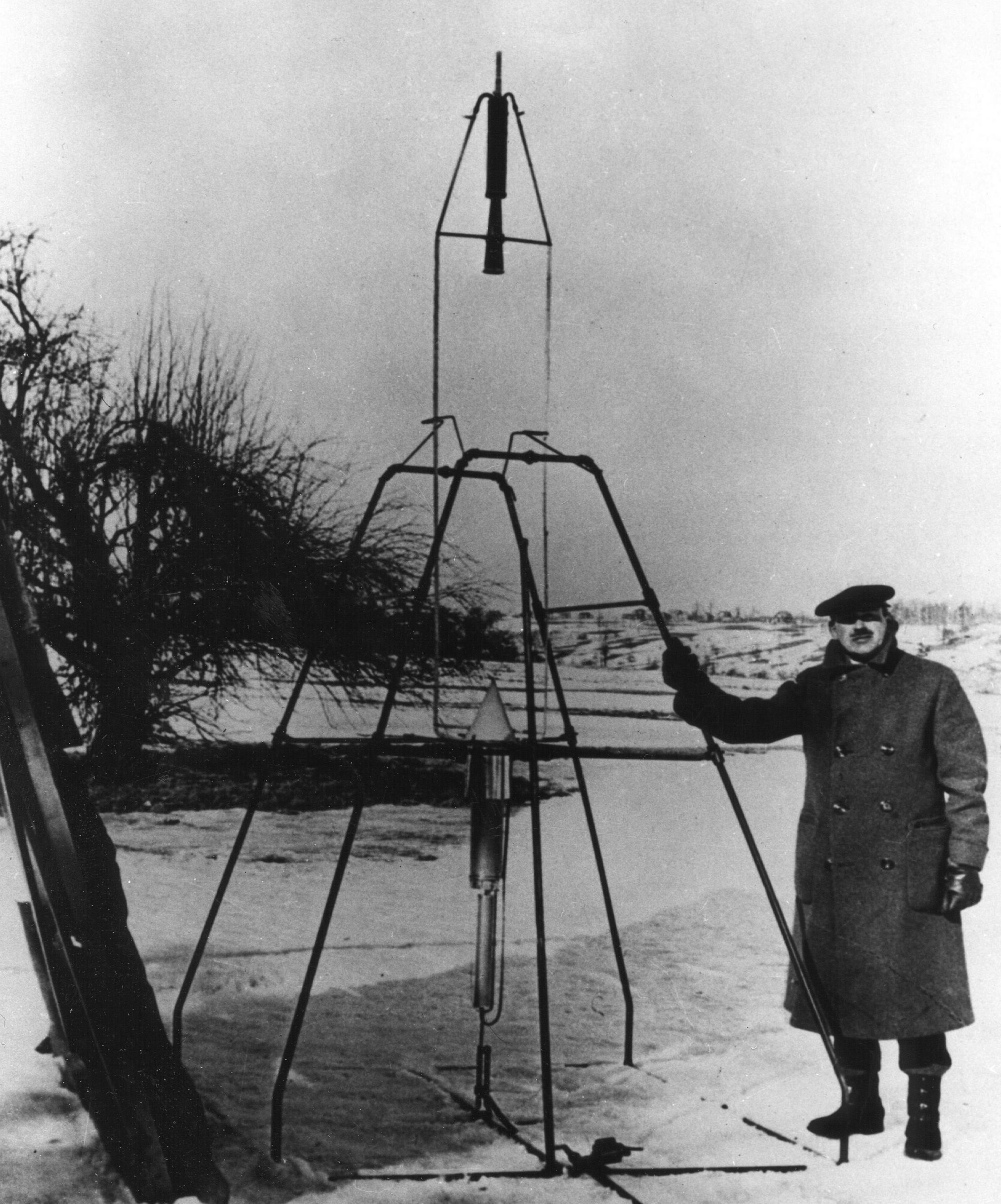
Other rocket pioneers include Hermann Oberth from Germany, who fired up his first liquid-fueled rocket engine in 1929. Although it lacked a cooling system, it operated successfully for a short time. Rocket engines are extremely powerful, capable of generating massive amounts of thrust and heat. However, historically, they have not always been as reliable as air-breathing engines because they must operate at extremely high pressures and temperatures, albeit for relatively short periods. Nevertheless, by the late 1930s, powerful rockets had been developed as long-range weapons, and several countries started ballistic missile programs. As shown in the image below, the German V-2 rocket (Vergeltungswaffe 2) was one of the world’s first long-range guided ballistic missiles. It was used primarily against targets in England and other parts of Western Europe.

After WWII, engineers in the U.S. utilized the V-2’s rocket engine components to aid in the development of their own rocket program. Wernher von Braun, Oberth’s assistant, would become a leader in advancing rocket technology. He was brought to the U.S. after WWII, along with other scientists, as part of Operation Paperclip.[2] By 1948, they had launched a two-stage rocket to an altitude of over 200 miles (322 km). After developing ballistic missiles for the U.S. Army, von Braun’s group became part of NASA. Their work was instrumental in developing NASA’s human space program, including the moon landings.
In 1936, James Hart Wyld built and tested the first regeneratively cooled liquid rocket engine, which used a jacket consisting of a double-walled rocket nozzle, allowing fuel to circulate as a coolant. Overheating was one of the major problems with early rocket engines, in that they became so hot that they often melted. With the regenerative system, the fuel was circulated in the jacket around the nozzle before entering the combustion chamber and igniting it with the oxidizer. Warming the fuel also aided in more efficient combustion. This design became so successful that it serves as the basis for nearly all modern liquid-propellant rocket engines. In most contemporary designs, the rocket engine’s nozzle utilizes multiple interwoven internal pipes or other cooling channels, where the fuel is first pumped before reaching the combustion chamber.

The X-15 research rocket-powered aircraft, as shown below, was flown 199 times from 1959 to 1968. This program provided a deep understanding of transonic, supersonic, and hypersonic flight at the edges of the Earth’s atmosphere. Hypersonic flight is typically defined as airspeeds exceeding Mach 5. The X-15 still holds the official world record for the highest speed ever recorded by a piloted, powered aircraft, at a speed of 4,519 miles per hour (7,274 km/h) or Mach 6.72 at 102,100 feet (31,120 m), which was set in 1967.

First Steps into Space
The late 1950s and 1960s witnessed tremendous technical growth in the fields of astronautical engineering and rocketry, much of which was not publicly known. Then, in 1957, the surprise launch of the Soviet Union’s Sputnik-1 became the first artificial satellite in space. Shortly after, the Soviets launched Sputnik 2, carrying a slightly heavier payload. It had four external antennas and broadcast radio pulses around the Earth. The success of the Sputnik launches precipitated an era of significant political and military uncertainty in the United States, first triggering the Sputnik Crisis and then the so-called “Space Race” between the United States and the Soviet Union. In 1960, Korabl-Sputnik 2 (Sputnik 5) was launched, carrying the dogs Strelka and Belka, who became the first living beings to survive a trip into space.
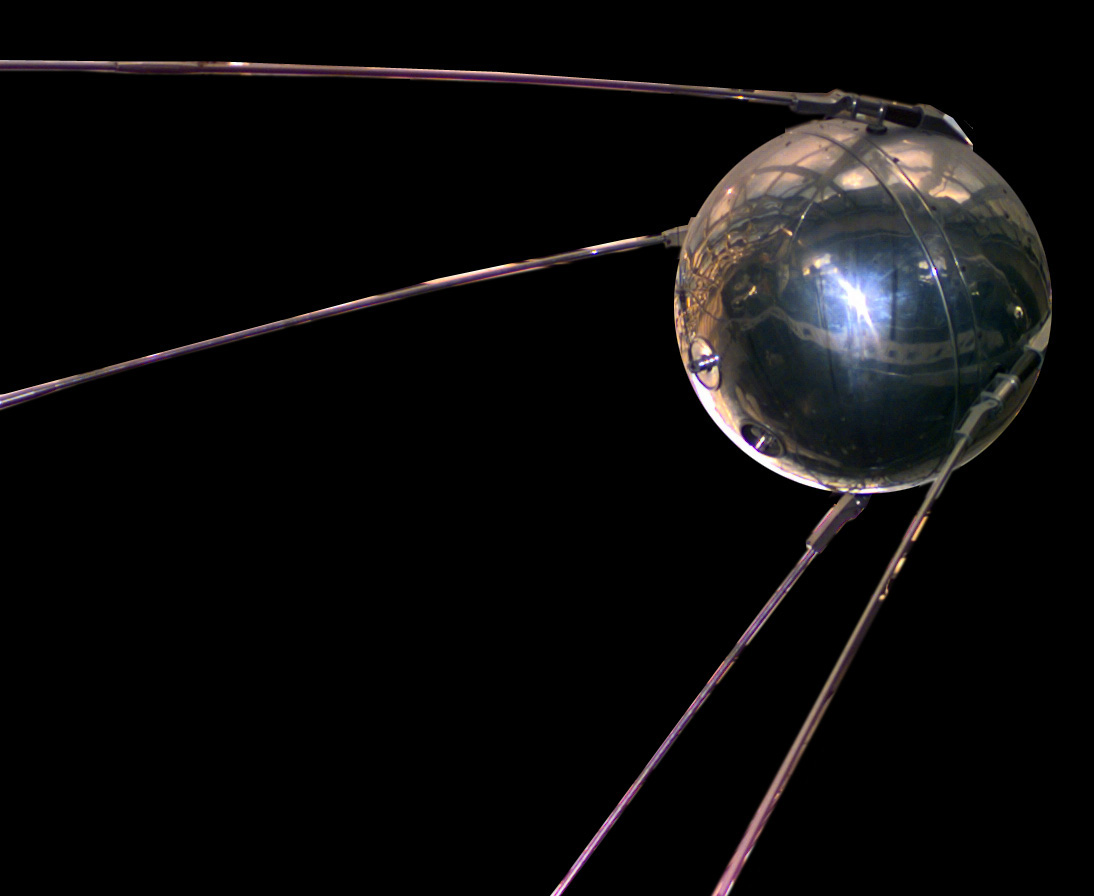
In 1958, the U.S. Government formed the National Aeronautics and Space Administration (NASA) as a reorganization of the National Advisory Committee for Aeronautics (NACA). This new organization soon launched its first satellite, Explorer 1. The satellite was launched by a Jupiter C rocket built by the Army Ballistic Missile Agency (ABMA). During this mission, the satellite carried out an experiment developed by Professor James Van Allen to detect the existence of radiation zones encircling Earth, which became known as the Van Allen radiation belts. Explorer 3 and Explorer 4 were also successfully launched in 1958.
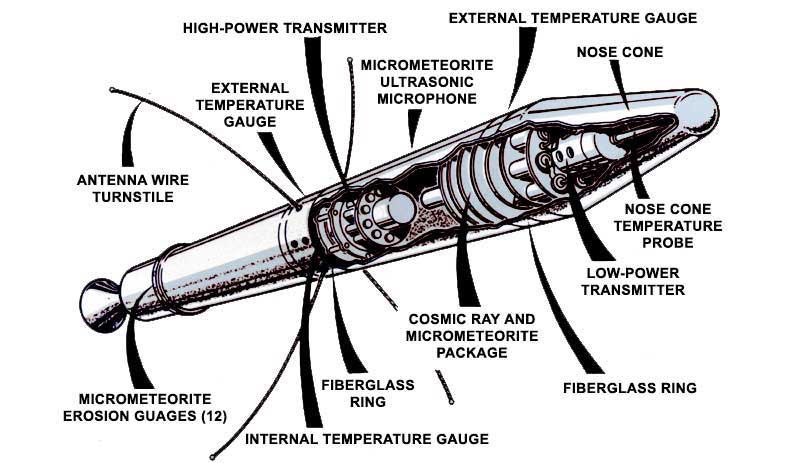
Project Mercury was initiated in 1958 and was the first human spaceflight program in the United States, operating from 1958 to 1963. However, Yuri Gagarin was the first human to fly in space in April 1961 when his Vostok 1 rocket carried him into space to complete one orbit of the Earth. The Soviet Union had secretly pursued the Vostok program in parallel with the Project Mercury. Several uncrewed Vostok missions had been launched before Gagarin’s flight to test various rockets and space capsules, but not all were successful. The first woman in space was Valentina Tereshkova, who flew in June 1963 aboard the Soviet Vostok 6.
Less than a month after Gagarin, in May 1961, the U.S. launched its first astronaut, Alan Shepard, on a suborbital flight. This mission was the third flight of the Mercury-Redstone (MR-3) rocket, which Werner von Braun and NASA engineers had developed. Shepard’s Freedom 7 capsule was launched from Cape Canaveral in Florida, reaching an apogee altitude of 116 miles (186.68 km)\footnote]By international agreement, space starts at 62 miles (100 km), which is called the Kármán line[/footnote] and a speed of 5,100 mph (8,207 km/h) before re-entering the atmosphere and parachuting into the Atlantic Ocean 300 miles (484 km) off the Cape. Alan Shepard was later to walk on the surface of the Moon as the commander of Apollo 14.
In February 1962, John Glenn became the fifth astronaut to fly in space and the first American to orbit the Earth completely, circling it three times during a five-hour flight. Humankind’s giant leap was never about stepping on the Moon for the first time but attaining Earth’s orbit. The success of the Friendship 7 mission allowed NASA to accelerate its efforts on the Project Mercury program. This program laid the foundations for the subsequent Gemini and Apollo programs, which reached their peak during the 1960s.

In 1963, NASA launched a series of communications satellites into orbit to demonstrate the feasibility of geosynchronous satellite communications from the Earth’s surface. The Gemini spacecraft program was also started, and the capsule carried two astronauts. The Gemini program aimed to develop space travel techniques to learn enough to eventually land astronauts on the Moon.
Ten Gemini missions were flown between 1965 and 1966, placing the U.S. firmly ahead of the Soviet Union in spacecraft development. The second piloted Gemini mission, Gemini 4, spent four days in space, and one of the astronauts, Edward H. White, Jr., performed the first spacewalk. The Gemini program was to provide essential information on human space activities. The program also included astronauts such as Neil Armstrong, John Young, and Edwin “Buzz” Aldrin, who would later walk on the Moon’s surface.
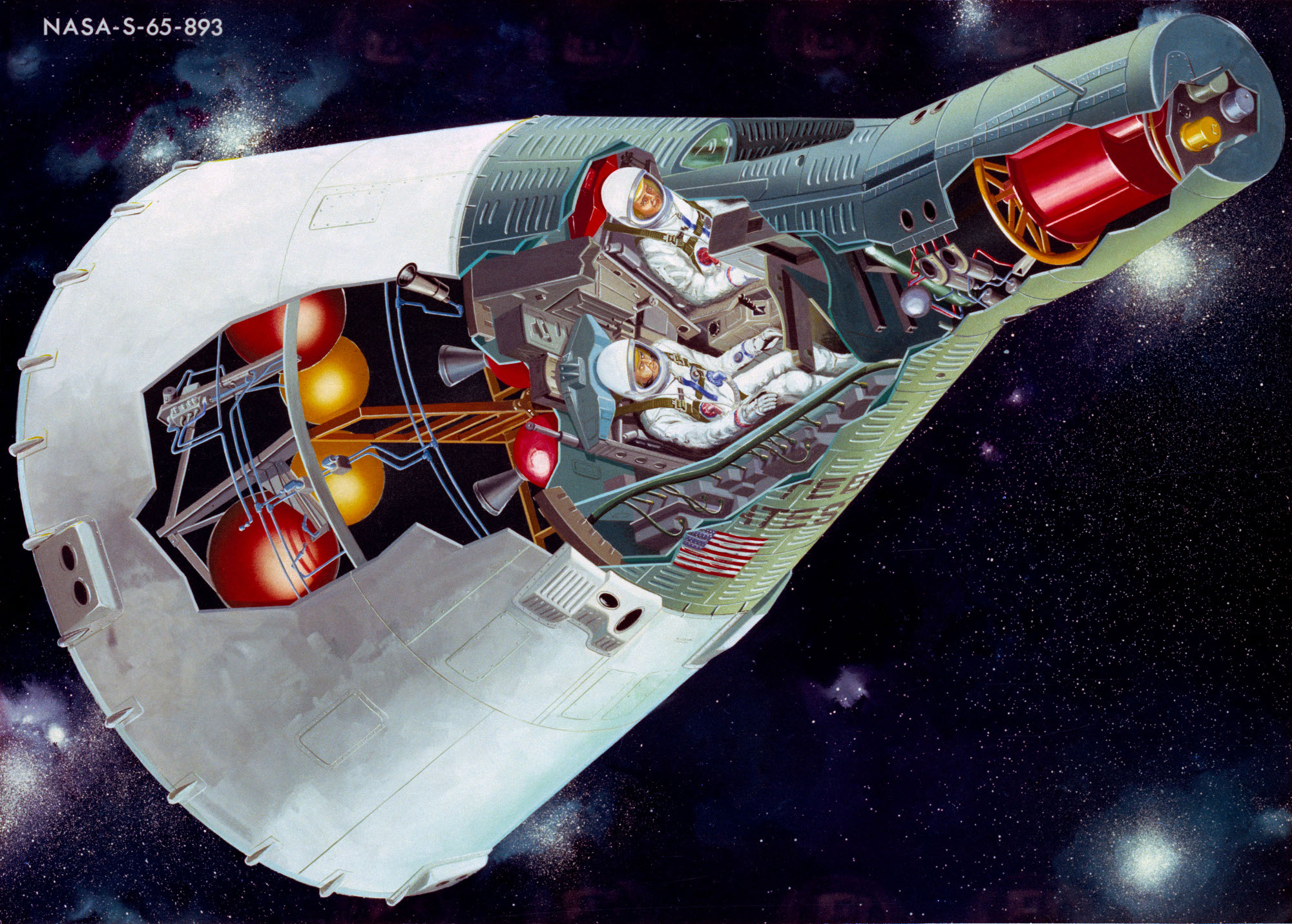
To the Moon!
In 1961, U.S. President John F. Kennedy issued a national challenge to land humans on the moon and return them safely to Earth by the end of the decade. The Apollo program was successful despite a significant setback in 1967 with the Apollo 1 cabin fire that killed the crew during a pre-launch test. The Apollo 8 mission demonstrated the feasibility of leaving Earth and orbiting the Moon, paving the way for further lunar landing preparations with the Apollo 9 and Apollo 10 missions, although these missions did not involve landings. The Apollo 8 mission was notable because it was the first time a spacecraft had left Earth’s orbit and headed into space.
The Apollo 11 flight in July 1969 led to Neil Armstrong and Buzz Aldrin Jr. successfully landing and walking on the surface of the Moon. After launching the three-stage Saturn V rocket, the spacecraft circled the Earth in a parking orbit. The third stage enabled a translunar injection, sending the spacecraft to the Moon, as illustrated in the schematic below. The next step was to undock with the third stage, then dock with the Eagle lunar module and pull it out. Afterward, the stage was discarded to fly off into a solar orbit.

After reaching the Moon, the spacecraft entered orbit, and the lunar module then undocked to begin the descent to the Lunar Surface, leaving Michael Collins to continue orbiting in the command module. The descent stage contained the rocket engine, fuel, and science and exploration equipment. After less than a day on the surface, the two astronauts returned to orbit on the ascent stage with about 50 lb (23 kg) of rocks and other lunar samples. After a trans-Earth burn, the spacecraft returned to Earth in 44 hours, followed by re-entry through the atmosphere, and eventually, the command module parachuted into the sea.
Five further Apollo missions, from 1972 to 1972 (Apollo 12 through Apollo 17), sent astronauts to explore the Moon. Unfortunately, the lunar landing mission for Apollo 13 was aborted after an oxygen tank exploded en route to the Moon, crippling the spacecraft. However, after six days during which the spacecraft circled the Moon, the Apollo 13 crew eventually returned safely to Earth.
The Apollo missions to the Moon were launched using a Saturn V (always pronounced as “Saturn Five”), a three-stage liquid-fueled rocket, as shown in the photograph below. The advantage of a multi-stage rocket is that it uses less fuel to take a payload into orbit, especially for high orbital altitudes, because the remaining weight of the vehicle is substantially reduced after each stage, and its rocket engines are jettisoned.
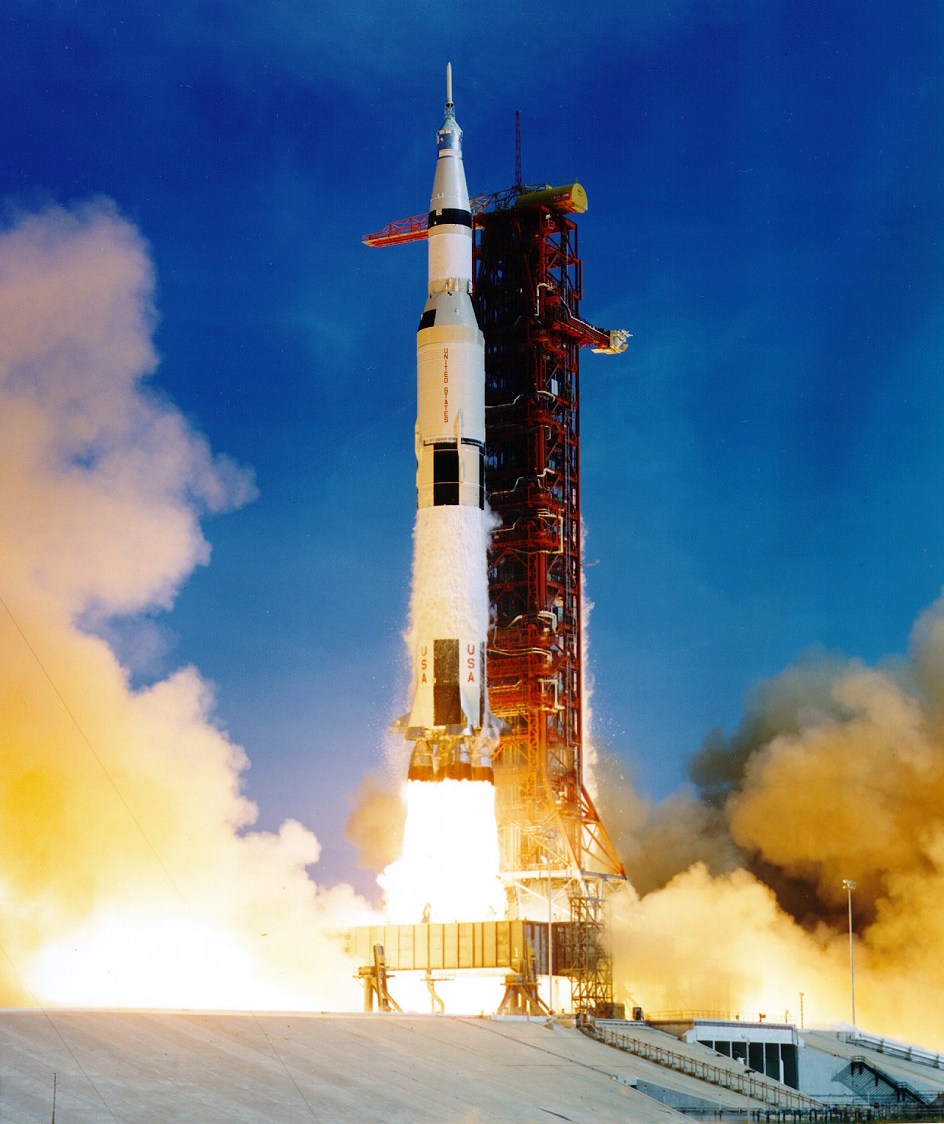
The first stage of the Saturn V used RP-1 (a specially densified kerosene) and liquid oxygen (LOX) as the propellant to power its five rocket engines, and the second and third stages used cryogenic liquid hydrogen (LH2) and LOX. The Saturn V was 85% propellant by mass on the launch pad. The first stage of this rocket produced about 34,500 kN (7,750,000 lb) of thrust at liftoff. During the first stage burn, the propellant flow rate to all five F-1 rocket engines was approximately 13,200 liters per second (3,500 gallons per second), with a ratio of about one part RP-1 to two parts LOX.
Exploring the Planets
Starting in 1962, a series of Mariner spacecraft were sent from Earth to map the surface of Mars, Venus, and Mercury. More missions were launched until 1973. Ten Mariner spacecraft were launched, seven of which were successful. Mariner 1, Mariner 3, and Mariner 8 failed because of equipment or launch vehicle malfunctions. The Mariner program also accomplished the first planetary flyby and gravity assist maneuver, including using “solar sails” to help propel the spacecraft.
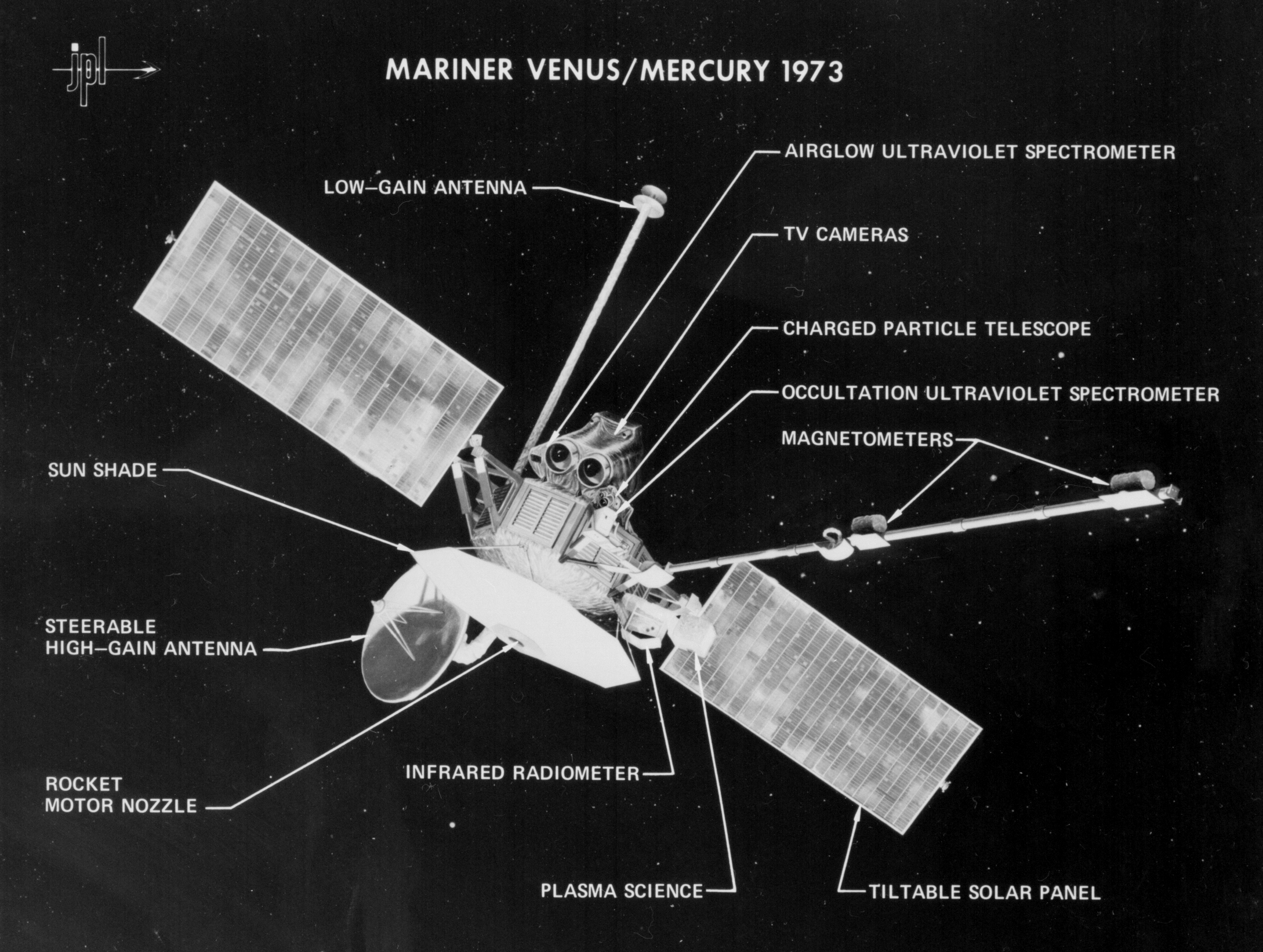
The planned Mariner 11 and Mariner 12 spacecraft were reallocated to the Voyager program and designated Voyager 1 and Voyager 2. In 1977, the two Voyager spacecraft were launched to send back detailed images of Jupiter and Saturn. Voyager 2 then continued to Uranus and Neptune. Both spacecraft remain active, continuing to explore interstellar space and transmit data. Voyager 1 crossed the heliopause in 1977 and has completed 45 years in space, with Voyager 2 not far behind. As of June 2023, Voyager 1 was reported to be 23.3 billion km (14.5 billion miles) from Earth. However, the nuclear fuel used for the Voyager spacecraft will eventually be depleted. So they will both be “condemned to wander the universe for eternity but remain the most distant emissary of humankind,” quoting Carl Sagan.
Communication & Earth Observation Satellites
Satellites now give real-time weather information, digital telecommunications, the internet, and GPS navigation systems that allow one to pinpoint their location within a few feet of anywhere on the planet. While the 1970s saw a significant increase in the number of communications and navigation satellite launches, there was also a substantial decline in crewed space flights. Nevertheless, by 1980, satellite communications had become commonplace, and since then, their capacity has expanded exponentially to carry digital television and internet services to any home with a satellite receiving dish. Most communication satellites operate in geostationary or geosynchronous orbits, which have periods equal to the Earth’s rotational speed (approximately 24 hours) at an altitude of roughly 22,300 miles (35,780 km).
The 1970s also saw the launch of satellites to support the Global Positioning System (GPS), also known as Navstar. This system provides geolocation and time information to a GPS receiver anywhere on the Earth. GPS has been one of the most successful technologies used by humankind and is available to anyone with a GPS receiver; one is even included in almost every automobile, smartphone, and smartwatch.
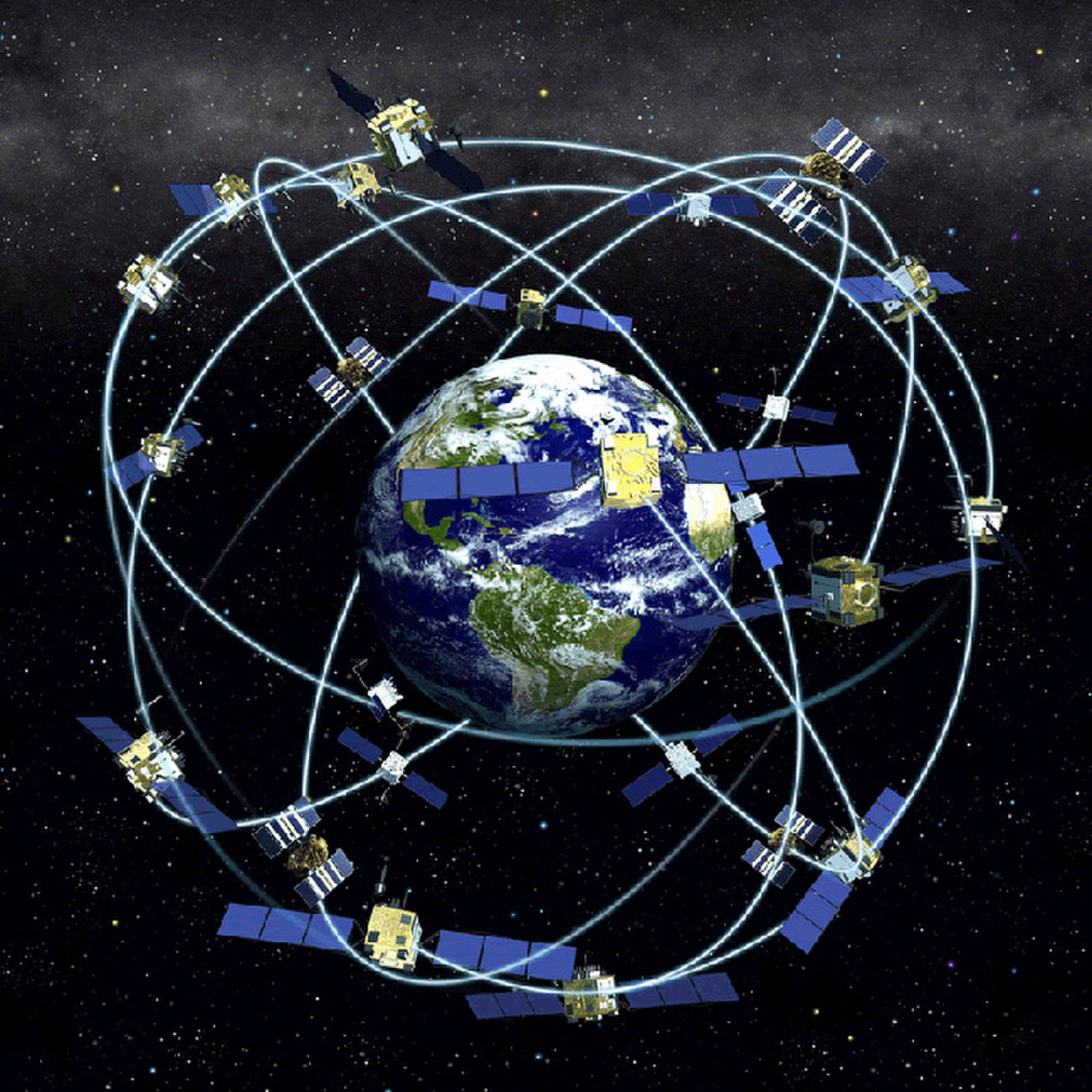
Landsat satellites have accumulated continuous imagery records of the Earth’s surface since 1972. The first satellite, the Earth Resources Technology Satellite, was renamed Landsat 1 in 1975. Subsequently, Landsat 8 was launched in 2013. Landsat instruments have acquired millions of images that are publicly available through the U.S. Geological Survey (USGS). The imagery is used in agriculture, cartography, geology, forestry, regional planning, and other applications. In addition, it has become a unique record of human activity on Earth, particularly in terms of urban expansion, deforestation, and the melting of the polar ice caps. The most recent satellite, Landsat 9, was launched in 2021.
SpaceX’s Starlink low-Earth-orbit (LEO) satellites are being launched almost every week. They provide advantages such as lower latency, greater coverage, and higher bandwidth, making them ideal for high-speed internet, particularly in remote and underserved areas. Starlink satellites orbit approximately 550 km (342 miles) above the Earth’s surface, compared to geostationary satellites, which orbit at approximately 35,786 km (22,236 miles). On the one hand, placing satellites in LEO reduces the time it takes for signals to travel between the satellite and the Earth, resulting in lower network latency, which is critical for real-time applications such as video conferencing and other interactive services. On the other hand, geostationary satellites, which orbit much farther from Earth, offer stable, comprehensive coverage with a single satellite and rely on well-established technology, making them better for broadcasting and longer-term communication requirements.
Era of the Space Shuttle
In 1981, the Space Shuttle program initiated a new era of human spaceflight with reusable components. The central reusable part, the Orbiter, was launched with the assistance of two external solid rocket boosters, which were jettisoned approximately 90 seconds into the flight. The boosters then parachuted into the sea, were recovered, and reused. The Orbiter’s flight to low-Earth orbit continued using its three main engines, followed by jettisoning the large external fuel tank. Upon returning to Earth, the Obiter re-entered the atmosphere and landed like a supersonic glider on a runway, albeit with a steep glide angle.
Despite its engineering complexity, the Space Shuttle was a very successful concept. It was used for military and commercial purposes, including the deployment of communications satellites, interplanetary probes, various science experiments, servicing of the Hubble Space Telescope, and construction of the International Space Station and its subsequent servicing. The Orbiters were retired in 2011 after 30 years of service and 135 cumulative missions. Unfortunately, the Shuttle concept had two catastrophic failures, one during launch and the other during re-entry with the Orbiter. Engineers had predicted during the design process that, because of the complexity of the concept, there was a 1 in 100 chance of failure.
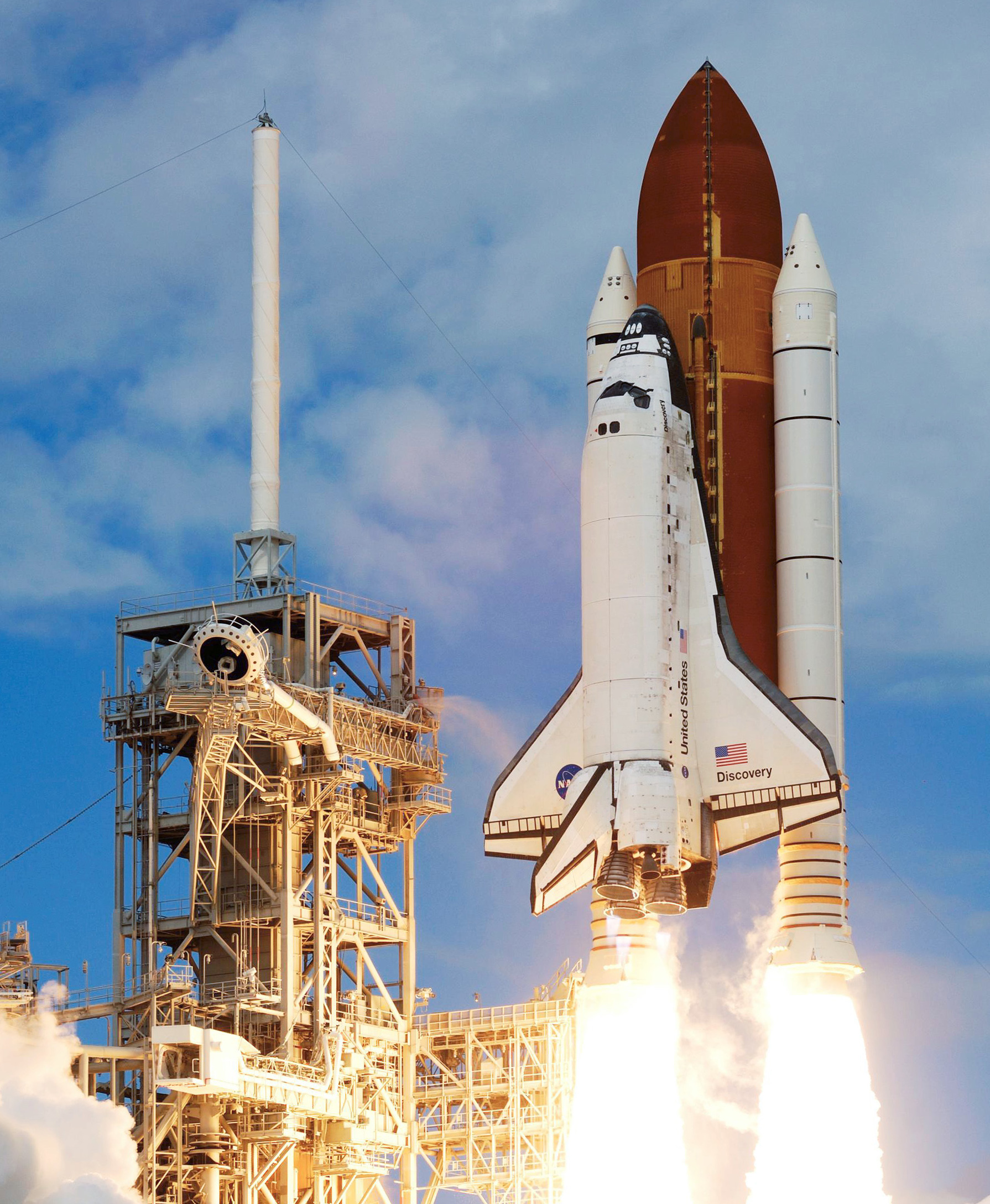
The 1980s and 1990s also saw the Space Shuttle used as a launch vehicle for further space exploration, as well as for a deeper understanding of the human environment on Earth. It launched various satellites for geographic, oceanic, and atmospheric studies, including weather forecasting. The Space Shuttle launched the Hubble Space Telescope (HST) into low Earth orbit in 1990, and the telescope remains operational for astronomy research. Another space telescope, the Kepler Space Telescope, was launched in 2009 into an orbit around the Sun. The Kepler telescope provided a wealth of information about our universe, and scientists discovered thousands of new planets; however, it ran out of fuel and was retired in 2018.

In December 2021, NASA launched the James Webb Space Telescope (JWST) into space. The JWST can view objects that are too distant for the Hubble Space Telescope to observe. It is expected to make many future advances in understanding astronomy and cosmology. The JWST operates approximately 930,000 miles (1,500,000 km) beyond Earth’s orbit around the Sun, compared to the Hubble, which orbits only 340 miles (550 km) above the Earth.
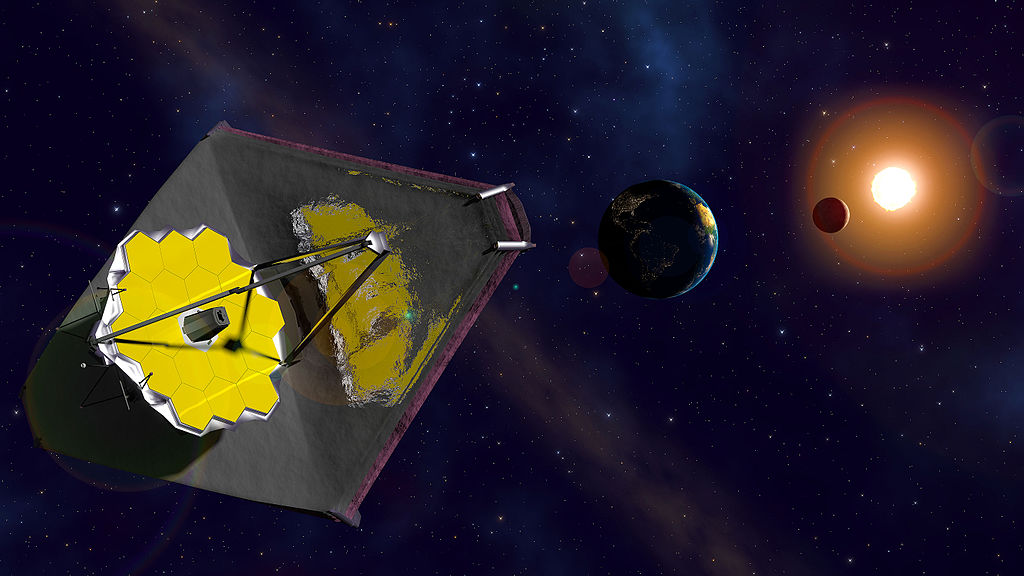
In early 2024, the JWST detected a galaxy called HD1, which existed only about 330 million years after the Big Bang. This discovery pushes the boundaries of understanding the early universe, revealing how galaxies formed and evolved in their infancy. HD1’s detection provides crucial data on the formation of the first stars and galaxies, as well as the conditions that led to the cosmic structures observed today. Additionally, JWST’s advanced capabilities allow it to peer into the atmospheres of exoplanets with unprecedented detail. It has detected signs of carbon dioxide and water vapor in the atmospheres of exoplanets, which helps scientists understand the conditions that might support life.
Space Stations
In 1971, the Soviet Union launched the first space station, Salyut 1, to test the feasibility of astronauts rendezvousing with a space station and conducting scientific research. However, the station was unsuccessful and was deorbited after only a few months. In 1972, Skylab was launched by a Saturn V rocket and became the second space station to orbit the Earth. Skylab was highly successful, and for approximately six years, it enabled visiting astronauts to conduct scientific experiments.
The International Space Station (ISS) is a habitable satellite parked in low Earth orbit. The Space Shuttle launched the first ISS components in 1998, which consisted of modules, external trusses, solar arrays, and other elements. It is a microgravity and space environment research laboratory that astronauts have occupied since November 2000. The ISS flies in Low Earth Orbit (LEO) with an orbital period of just over 90 minutes. The ISS is large and low enough to be seen with the naked eye on a dark night; the reflecting solar panels appear as a bright star that quickly arcs across the horizon. Crew members use the ISS to conduct various types of scientific experiments, and it is expected to remain operational for many years to come. Eventually, the ISS will be deorbited and burn up in the Earth’s atmosphere.
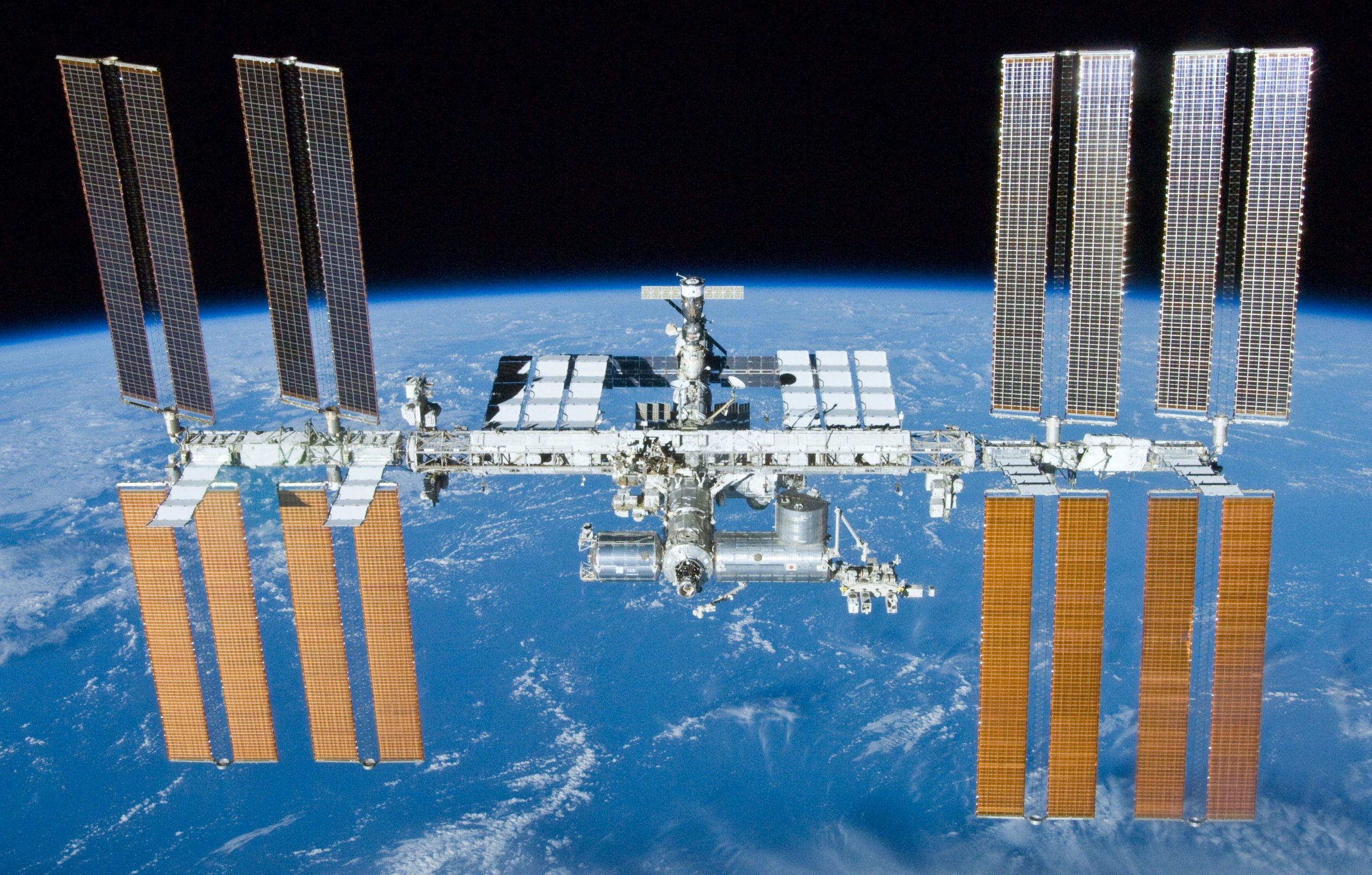
Recently, astronauts aboard the ISS have been testing a new space habitat design called the Nexus module. This module includes expandable living spaces and advanced life support systems designed to enhance comfort and efficiency. The Nexus module is part of a broader effort to improve the design and functionality of future space habitats, making them more adaptable and capable of supporting more extended missions. Its development could significantly help in long-duration space exploration, potentially paving the way for more ambitious missions to the Moon, Mars, and beyond.
NASA Space Launch System (SLS)
As shown in the photograph below, the NASA Space Launch System (SLS) is a heavy-lift vehicle that has been under development since 2011. The contractors for the vehicle include Aerojet Rocketdyne, Northrop Grumman, Boeing, and United Launch Alliance. The first uncrewed launch was scheduled for August 29, 2022, but a problem with one of the rocket engines and two back-to-back hurricanes in Florida delayed the launch. The SLS finally lifted off for its flight debut on November 16, 2022. This test flight propelled the Orion capsule, without any astronauts on board, on a round-trip mission beyond the moon, covering a distance of over 1.3 million miles and splashing down successfully back on Earth 26 days later.
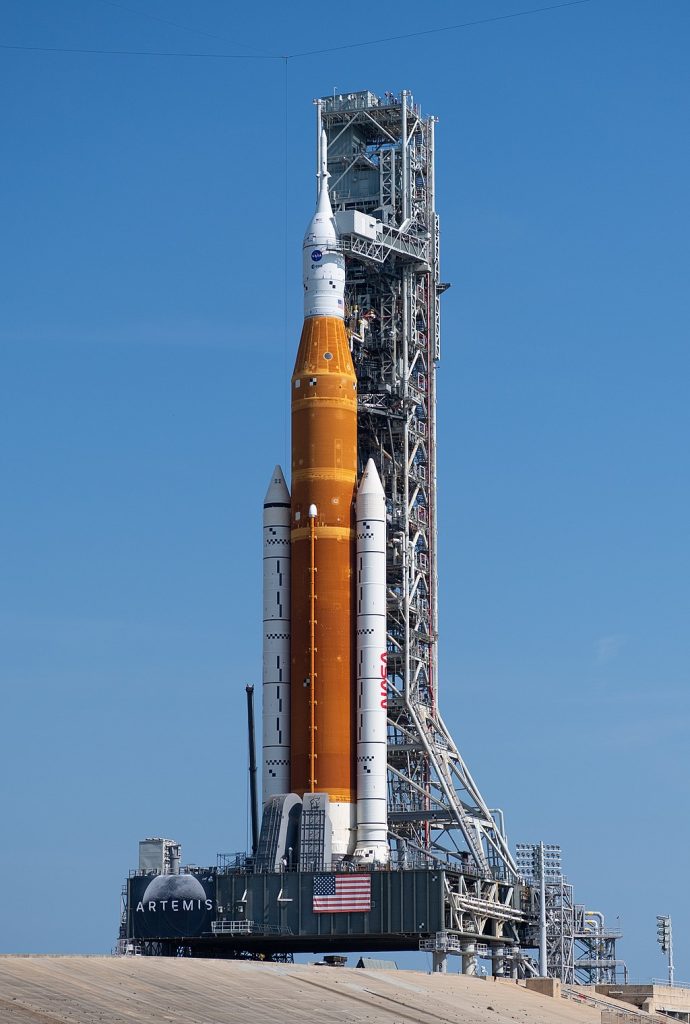
In the long term, the SLS will become NASA’s primary launch vehicle for deep space exploration plans. It is a huge launch vehicle, almost 322 ft (98 m) tall, and so comparable in size and weight to the mighty Saturn V. It holds 700,000 gallons (nearly 3.2 million liters) of propellant comprising cryogenic liquid hydrogen (LH) and oxygen (LOX). It features four first-stage RS-25 rocket engines, the same ones previously used on the Space Shuttle. Two solid-fuel boosters burn PBAN, a mixture of ammonium perchlorate and aluminum powder. At the point of liftoff, the SLS weighs 5.8 million lb (2.6 million kg).
Notable U.S. spaceflight launches, covering a range of missions from early milestones to recent advancements.
| Date | Mission | Vehicle | Description |
| 1961-05-05 | Mercury-Redstone 3 | Redstone R&D Rocket | First American human-crewed spaceflight (Alan Shepard). |
| 1961-07-21 | Mercury-Redstone 4 | Redstone R&D Rocket | Second Mercury flight (Virgil Grissom). |
| 1962-02-20 | Mercury-Atlas 6 | Atlas LV-3B | First American orbital flight (John Glenn). |
| 1965-03-23 | Gemini 3 | Titan II | First Gemini flight (Gus Grissom, John Young). |
| 1966-12-15 | Gemini 7 | Titan II | Long-duration spaceflight (Frank Borman, Jim Lovell). |
| 1969-07-16 | Apollo 11 | Saturn V | First moon landing (Neil Armstrong, Buzz Aldrin, Michael Collins). |
| 195-07-15 | Apollo-Soyuz Test Project | Saturn IB | First international crewed spaceflight (U.S. and USSR). |
| 1981-04-12 | STS-1 (Columbia) | Space Shuttle Columbia | First Space Shuttle flight. |
| 1990-04-24 | Hubble Space Telescope | Space Shuttle Discovery | Deployment of the Hubble Space Telescope. |
| 1998-11-20 | Zarya | Space Shuttle Discovery | Launch of the first module of the International Space Station (ISS). |
| 2004-01-08 | Spirit | Mars Exploration Rover | Mars rover landing (NASA’s Spirit). |
| 2011-05-16 | Endeavour STS-134 | Space Shuttle Endeavour | Final assembly of the ISS, including the Express Logistics Carrier. |
| 2020-05-30 | Crew Dragon Demo-2 | Falcon 9 | First crewed launch from U.S. soil since 2011 (NASA astronauts Bob Behnken and Doug Hurley). |
| 2021-04-23 | Mars 2020 (Perseverance) | Atlas V 541 | Landing of the Perseverance rover on Mars. |
| 2024-01-30 | Artemis I | Space Launch System (SLS) | Uncrewed test flight of the SLS and Orion spacecraft. |
Artemis Program
NASA’s Artemis program aims to return humans to the Moon and establish a sustainable presence there. Its ambitious plans extend beyond the Moon to Mars. The program, named after the twin sister of Apollo from Greek mythology, seeks to achieve several significant goals. It also includes the construction of the Lunar Gateway, a space station planned to orbit the Moon. This station will be a staging point for lunar surface missions and a platform for scientific research and international cooperation.
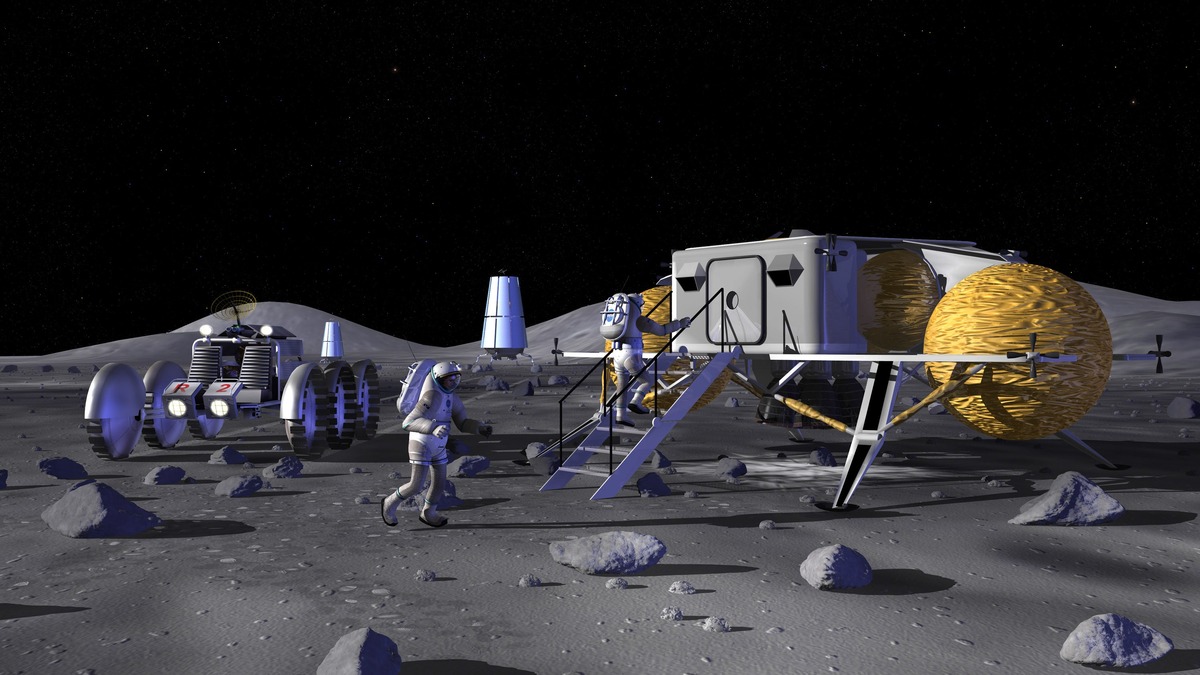
The Artemis I mission, the program’s first step, successfully tested the Space Launch System (SLS) rocket and the Orion spacecraft in an uncrewed flight around the Moon. This mission demonstrated the systems’ capabilities needed for future crewed missions. Following Artemis I, Artemis II will be a crewed mission that will orbit the Moon, paving the way for the subsequent Artemis III mission, which aims to land astronauts on the lunar surface. The target for this landing is the Moon’s South Pole, where water ice is believed to be present. This ice could be crucial for future lunar exploration, providing a valuable resource for long-term missions.
SpaceX has recently started developing the “Starship HLS” (Human Landing System) variant for NASA’s Artemis program. This version of Starship is designed to land astronauts on the lunar surface as part of the Artemis missions. Overall, the Artemis program is focused on establishing a long-term human presence on the Moon, which involves developing new technologies for life support, habitat construction, and resource utilization. This initiative is expected to inspire a new generation of explorers and scientists by demonstrating the possibilities of human space exploration and laying the groundwork for future missions to other planets.
Commercial Space Ventures
Over the last decade, commercial and privately funded companies, such as SpaceX and Blue Origin, have developed launchers with reusable first stages, thereby demonstrating the technical feasibility of reusing many components, including rocket engines. In addition, advances in computing and the miniaturization of electrical and other components have brought small satellites (i.e., those weighing 100 kg or less) to the forefront of commercial and research activities. The Planet Company is notable for its fleet of 3U CubeSats, also known as nanosatellites, which provide daily global coverage in the visible spectrum with a ground resolution of approximately 5 meters (15 feet). SpaceX has also begun to launch nanosatellites as part of a low-cost global communications network called Starlink.
Currently, two commercial spacecraft companies in the United States, United Launch Alliance (ULA) and SpaceX, are conducting frequent launches. ULA is operated by Lockheed-Martin and Boeing, providing spacecraft launch services to the Department of Defense and NASA. ULA operates expendable launch systems based on the Atlas and Delta launch system families, which have been used for decades to carry a variety of payloads, including telecommunications satellites and probes for interplanetary exploration. A third company, Blue Origin, with its recent success in launching the New Glenn spacecraft, may not be far behind.
SpaceX aims to create technologies to reduce space transportation costs and enable the colonization of outer space. It has developed the reusable Falcon series of launch vehicles, the first stage of which can be landed back at the launch site. The Falcon 9 uses the remaining fuel to reignite its engines in a series of decelerating burns to return to Earth. These burns help adjust the rocket’s speed and reorient the vehicle into the proper position to enter the Earth’s atmosphere and toward the final landing spot.
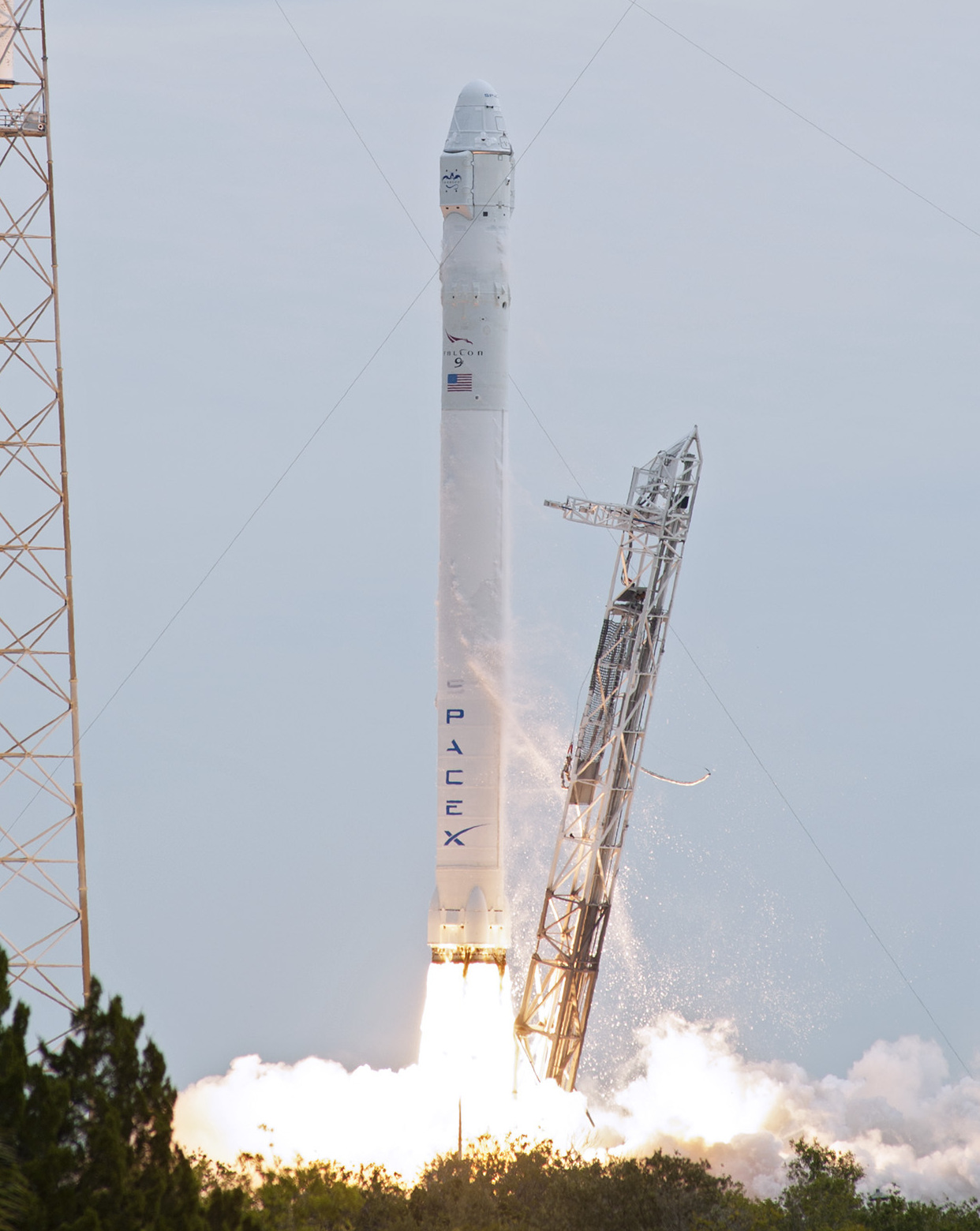
The SpaceX Dragon spacecraft was initially designed to supply the ISS with cargo. Its crewed version, Crew Dragon, has since expanded the scope of human spaceflight. The first operational mission, Crew-1, launched on November 16, 2020, transporting four astronauts to the ISS. Another milestone was achieved on September 16, 2021, with the Inspiration4 mission, the first all-civilian mission to orbit. Over three days, the crew conducted scientific and medical experiments, engaging in public outreach activities that highlighted the accessibility of space exploration to non-professional astronauts.
SpaceX’s Polaris Dawn mission launched on September 10, 2024. This all-private astronaut mission achieved several milestones, including reaching a highly elliptical orbit with an apogee of approximately 1,400 km (870 m), the farthest any human has traveled from Earth since NASA’s Apollo program. The mission also provided valuable data as the crew passed through parts of the Van Allen radiation belt, contributing to research on human exposure to space radiation. Additionally, the astronauts successfully conducted the first commercial spacewalk, marking a significant milestone in private space exploration.
SpaceX has also developed the Falcon Heavy, the world’s most powerful operational launch vehicle. Its maiden flight in February 2018 demonstrated its extraordinary capabilities. The Falcon Heavy can lift nearly 141,000 pounds (64 metric tons) into low Earth orbit, more than twice the payload capacity of the next closest operational vehicle, the ULA Delta IV Heavy. Its first stage consists of three Falcon 9 nine-engine cores, with 27 engines generating over 5 million pounds (2,300 metric tons) of thrust at liftoff. This immense power enables the Falcon Heavy to support a wide range of missions, from launching heavy payloads to deep space exploration.
Blue Origin has made significant strides in the space industry with the successful launch of its New Glenn rocket. On January 16, 2025, New Glenn embarked on its maiden flight, marking Blue Origin’s entry into orbital space missions. Standing over 320 feet (97.5 meters) tall, the New Glenn rocket is one of the largest space vehicles ever constructed. This positions Blue Origin as a potential competitor to SpaceX in the realm of orbital launches. Despite losing the first-stage booster during descent, the mission is considered a significant achievement for the company. Industry experts anticipate that Blue Origin’s entry into the commercial space sector will foster healthy competition, drive innovation, and potentially reduce costs.
Air-Launched Rockets
Other types of space vehicles may be carried to relatively high altitudes using a conventional airplane and then launched into flight, much like the X-15 was launched initially. At this point, the rocket engines ignite, propelling the vehicle upward into space. The Pegasus, shown below, is an example of this less conventional launcher design type.

The Pegasus rocket is an air-launched vehicle that delivers small payloads into low Earth orbit. Released from its carrier aircraft at approximately 40,000 ft (12,000 m), it uses three solid-propellant stages and an optional monopropellant fourth stage to boost into space. The first stage features wings that generate lift in the atmosphere, allowing for faster altitude gain before being jettisoned. Afterward, the vehicle operates as a pure rocket until it reaches orbital speeds and altitudes. With a payload capacity of about 1,000 pounds (455 kilograms), Pegasus is suited for small satellite launches and specialized missions.
Virgin Galactic has developed an air-launched vehicle capable of delivering payloads of approximately 1,100 lb (500 kg) to low orbital altitudes. The system uses White Knight Two, a mothership that carries the spacecraft SpaceShip Two to a cruising altitude. At this point, the rocket separates, ignites its boosters, and ascends out of the atmosphere. The single engine of SpaceShipTwo used a polyamide fuel with nitrous oxide as the oxidizer. Two SpaceShipTwo vehicles, Enterprise and Unity, were completed and flown. After 13 flights, these spacecraft were retired, marking the end of an era for Virgin Galactic’s early efforts. The company has since shifted its focus to next-generation Delta-class space vehicles designed to improve performance, increase passenger capacity, and reduce turnaround times between flights. Test flights for the Delta-class spaceplanes are expected to begin in 2025, with commercial service anticipated to follow in 2026.
SpaceX Starship
The Starship is a super-heavy-lift launch vehicle developed by SpaceX. It stands 120 meters (394 feet) in height and has a liftoff weight of 5,000 tons, making it one of the largest and most powerful rockets ever developed. Its net thrust surpasses that of NASA’s SLS. As shown in the photograph below, the Starship is a two-stage-to-orbit launch vehicle. The first stage, known as Super Heavy, serves as a booster to propel the second stage, also referred to as Starship, into space. The first two Starship launches were unsuccessful, but the third launch successfully achieved a suborbital flight. Future Starship missions aim to achieve orbital flights, demonstrating the reusability of both stages, and will include objectives such as payload deployments, lunar landings for NASA’s Artemis program, and eventually crewed missions to Mars. The iterative testing process remains at the core of SpaceX’s strategy to revolutionize space exploration.

Both the Super Heavy booster and Starship spacecraft are powered by Raptor rocket engines, which burn a combination of liquid methane and liquid oxygen (Methalox). A key design goal for both Super Heavy and Starship is complete reusability, and they are intended to perform controlled landings. In a fully reusable configuration, Starship is designed to have a payload capacity of 150 tonnes (330,000 lb) to low Earth orbit. When expended (not recovered), it could carry up to 250 tonnes (550,000 lb) to orbit. One of the unique design features of Starship is its ability to be refueled in orbit. SpaceX plans to launch special tanker Starships to refuel Starships already in low Earth orbit, providing the propellant needed to reach the Moon and Mars.
Notable commercial space ventures, highlighting key companies and their significant activities or achievements.
| Company | Founded | Key Activities | Notable Achievements |
| SpaceX | 2002 | Rocket launches, spacecraft, satellite deployment | First privately-funded spacecraft to reach orbit; First privately-funded spacecraft to dock with the ISS; First private company to land a rocket booster back on Earth. |
| Blue Origin | 2000 | Suborbital spaceflights, orbital rockets, space tourism | Successfully launched and landed New Shepard; the First private company to send humans to space (NS-16 mission). |
| Virgin Galactic | 2004 | Suborbital space tourism | First commercial space tourism flight (VSS Unity); Ongoing development of space tourism. |
| Boeing | 1916 | Spacecraft, satellite deployment, space station modules | Developed the CST-100 Starliner for crewed missions; Provides spacecraft for ISS. |
| Sierra Nevada Corporation | 1963 | Spacecraft, satellite technology, space tourism | Developing the Dream Chaser spacecraft for cargo and crew missions; Involved in various space technology projects. |
| Northrop Grumman | 1939 | Spacecraft, satellite technology, space station modules | Developed Cygnus spacecraft for cargo resupply missions to the ISS; Engaged in various space technology and defense projects. |
| Rocket Lab | 2006 | Small satellite launches, space systems | Successful launches with Electron rocket; Developed Photon satellite platform. |
| Astrospace | 2018 | Space missions, satellite technology | Focused on advanced space propulsion and satellite technologies. |
| Relativity Space | 2015 | Rocket manufacturing, space launches | Developing Terran 1 rocket using 3D printing technology; Focused on reducing rocket production costs. |
| Axiom Space | 2016 | Private space station, space tourism | Plans to build the first commercial space station; Developing missions for private astronauts and researchers. |
| OneWeb | 2012 | Satellite constellation for global internet | Deploying a large constellation of satellites to provide global internet coverage. |
| Planet Labs | 2010 | Earth observation satellites | Operates a large fleet of small satellites for Earth imaging and data collection. |
Non-U.S. Space Activities
While the U.S. dominated the early era of space exploration, other countries and space agencies have achieved several significant milestones and advancements. The Soviet Union, now Russia, played a pioneering role in space exploration. On October 4, 1957, the Soviet Union launched Sputnik 1, the first artificial satellite, marking the beginning of the space age and initiating the space race. Following this, on September 12, 1959, Luna 2 became the first human-made object to impact the Moon, demonstrating early capabilities in interplanetary exploration. On April 12, 1961, Vostok 1 carried Yuri Gagarin, the first human to orbit Earth, a landmark achievement in human spaceflight.
The Soviet Union continued its advancements with Voskhod 2 on March 18, 1965, during which cosmonaut Alexei Leonov performed the first spacewalk, stepping outside the spacecraft for a brief period. The Soviet Union’s space exploration efforts expanded further with Luna 9, which successfully achieved the first soft landing on the Moon on February 3, 1966. They transmitted the first pictures from the lunar surface. On August 17, 1970, Venera 7 successfully landed on Venus, providing critical data about the planet’s atmosphere and surface conditions. Russia’s continued involvement in space exploration was highlighted by the Soyuz MS-19 mission on August 9, 2021, which featured a film crew mission to the International Space Station (ISS), showcasing an ongoing commitment to human spaceflight and international cooperation.
China has made significant strides in space exploration. On October 15, 2003, Shenzhou 5 marked China’s first crewed spaceflight, with astronaut Yang Liwei becoming the first Chinese citizen to orbit Earth. China furthered its lunar exploration with Chang’e 1, launched on October 24, 2007, which mapped the Moon’s surface. On December 2, 2013, Chang’e 3 landed the rover Yutu (Jade Rabbit) on the Moon, achieving China’s first successful soft landing on the lunar surface.
The European Space Agency (ESA) has also made notable contributions to space exploration. On March 2, 2004, Rosetta became the first spacecraft to land a probe, Philae, on a comet (67P/Churyumov-Gerasimenko), providing valuable data on cometary materials and behavior. ESA’s Gaia mission, launched on 19 December 2013, aims to create a comprehensive 3D map of the Milky Way galaxy, providing detailed data on stars and their movements.
India’s space achievements include Chandrayaan-1, launched on October 22, 2008. This mission made significant discoveries, including the presence of water molecules on the Moon. On November 5, 2013, India’s Mangalyaan (Mars Orbiter Mission) entered Mars’ orbit, making India the first Asian country to achieve this feat and the fourth space agency to reach Mars.
Japan’s contributions include Hayabusa, which was launched on September 24, 2003. This mission collected samples from the asteroid Itokawa and returned them to Earth, marking a significant achievement in exploration. The follow-up mission, Hayabusa 2, launched on December 3, 2014, targeted the asteroid Ryugu and successfully collected samples to study the origins of the solar system. The United Arab Emirates (UAE) recently joined the ranks of space explorers with the launch of the Hope Probe on 20 July 2020. This mission, which entered Mars’ orbit in 2021, aims to study the Martian atmosphere.
Notable non-U.S. space activities, highlighting key missions and achievements from various space agencies worldwide.
| Mission/Activity | Launch Date | Space Agency/Country | Spacecraft | Target/Objective | Key Achievements |
| Sputnik 1 | 1957-10-2004 | Soviet Union | Sputnik 1 | First artificial satellite | First human-made object to orbit Earth. |
| Vostok 1 | 1961-04-2012 | Soviet Union | Vostok 1 | First human spaceflight | First manned spaceflight (Yuri Gagarin). |
| Luna 2 | 1959-09-2012 | Soviet Union | Luna 2 | Moon | First human-made object to impact the Moon. |
| Luna 9 | 1966-02-2003 | Soviet Union | Luna 9 | Moon | First successful soft landing on the Moon. |
| Venera 7 | 1970-08-2017 | Soviet Union | Venera 7 | Venus | First successful landing on Venus. |
| Chandrayaan-1 | 2008-10-2022 | India | Chandrayaan-1 | Moon | Discovered water molecules on the Moon. |
| Chang’e 4 | 2018-01-2003 | China | Chang’e 4 | Moon (far side) | First mission to land on the far side of the Moon. |
| Tiangong 1 | 2011-09-2029 | China | Tiangong 1 | Space Station | China’s first space station module. |
| Rosetta | 2004-03-2002 | European Space Agency (ESA) | Rosetta | Comet 67P/Churyumov-Gerasimenko | First spacecraft to land on a comet (Philae). |
| ExoMars 2020 | 2021-07-2020 | European Space Agency (ESA) / Roscosmos | Rosalind Franklin Rover | Mars | Joint ESA-Russian rover mission to search for signs of life. |
| Akasaki | 2003-09-2024 | Japan | Akasaki | Space Debris | An experiment to study space debris and its impact. |
| Hayabusa2 | 2014-12-2003 | Japan | Hayabusa2 | Asteroid Ryugu | Collected samples from asteroid Ryugu. |
Deep Space & Beyond
Ventures into deep space and beyond our solar system may start to infringe on the final frontier, whatever that is. For example, it has become clear that with our current technology, it is impossible to send astronauts into deep space and expect them to return to Earth safely. The distances in deep space are enormous, to say the least. Alpha Centauri, the Earth’s nearest Sun-like star system, is located 4.37 light-years away from Earth, which is approximately 4.37 × 10^14 miles (7.2 trillion km) away.
Interstellar probes and robotic explorers, such as Voyager 1 and 2, continue to send back data. Voyagers 1 and 2 were designed to take advantage of a rare planetary alignment to study the outer solar system up close. Voyager 1 flew past Jupiter, Saturn, and Saturn’s largest moon, Titan. Voyager 2 targeted Jupiter, Saturn, Uranus, and Neptune. However, it has taken several decades for them to reach their current position, which is located just beyond our solar system, and it will take them another 400,000 years to arrive at the nearest stars.
NASA’s New Horizons probe, shown in the image below, was launched in 2006. In 2015, it made history with a flyby of Pluto, providing the first-ever close-up photos of the distant dwarf planet and its moons. After this, New Horizons continued its journey deeper into the Kuiper Belt, a region of icy bodies beyond Neptune. As of 2024, New Horizons remains operational, providing valuable insights into the formation and evolution of objects in the outer solar system.
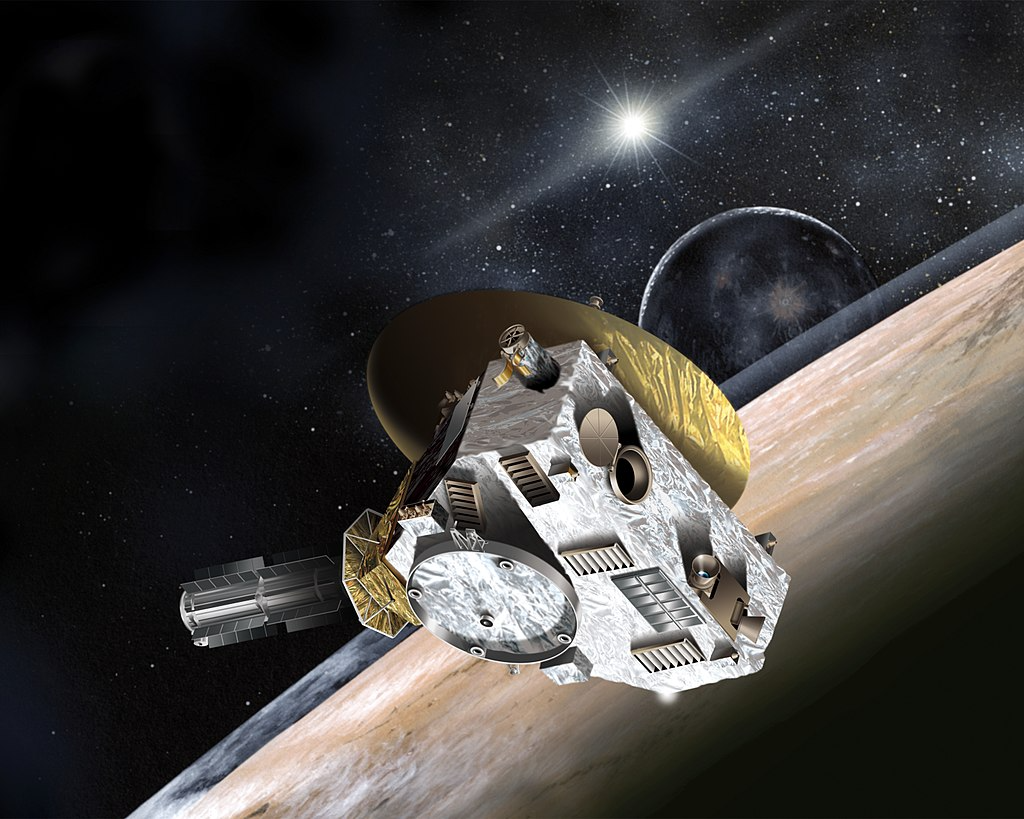
The OSIRIS-REx and Hayabusa2 missions represent significant milestones in space exploration, focusing on retrieving samples from near-Earth asteroids. NASA’s OSIRIS-REx launched in 2016 to study the asteroid Bennu, successfully collecting samples in October 2020 and returning them to Earth in September 2023. JAXA’s Hayabusa2, launched in 2014, targeted the asteroid Ryugu, collecting samples during two events in 2019 and returning them to Earth in December 2020. Both missions set out to analyze the composition and physical properties of these carbon-rich asteroids, providing insights into the early solar system and the origins of organic compounds and water that may have seeded life on Earth. These robotic missions also demonstrated advanced capabilities in space navigation and control, high-resolution imaging, autonomous operations, and sample collection, setting the stage for future asteroid exploration.

The Parker Solar Probe, as shown in the image below, which was launched by NASA in 2018, is a groundbreaking mission to study the Sun’s outer corona and unravel mysteries about the solar wind and space weather. It is the closest spacecraft to the Sun, reaching within 3.8 million miles (6.1 million kilometers) of its surface and traveling at record-breaking speeds of 430,000 miles per hour (700,000 kilometers per hour). Equipped with a revolutionary heat shield, the probe endures extreme temperatures while collecting unprecedented data on solar phenomena. Key discoveries include insights into the acceleration of the solar wind, magnetic field “switchbacks,” and the Sun’s coronal heating. As of January 2025, Parker continues to transmit valuable data, enhancing our understanding of the Sun’s influence on the solar system and improving space weather forecasting.
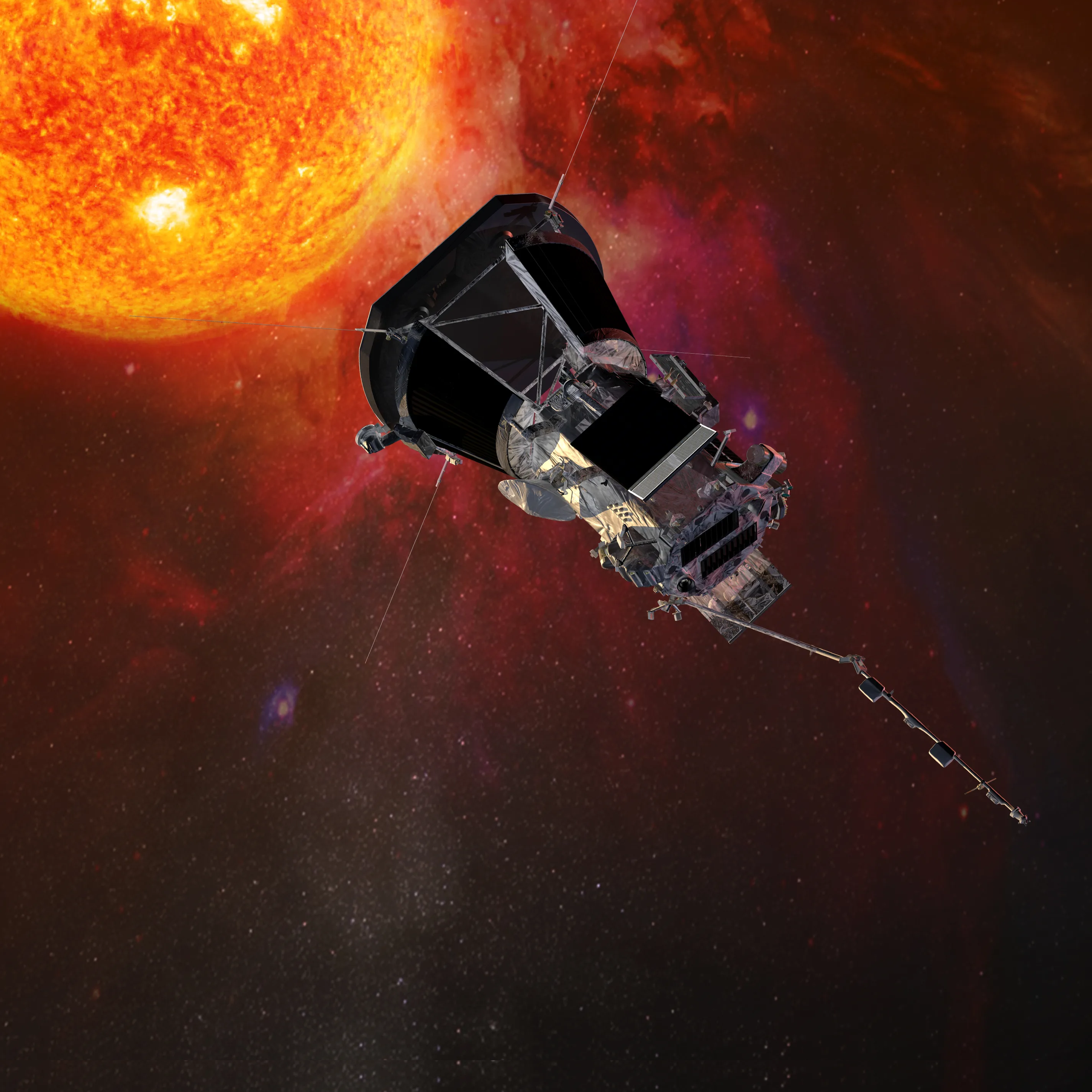
All of these robotic probes carry humankind’s vision and inspiration, hoping that one day, humans may be able to head out into deep space. However, many challenges and considerations come with venturing into deep space. These include the vast distances involved, the need for advanced propulsion systems, life support for long-duration missions, and the potential health effects of prolonged space travel on astronauts. The time it would take to reach even the closest stars at our current technological level is prohibitively long. Additionally, the harsh conditions of deep space, including cosmic radiation and microgravity, pose risks to human explorers and their spacecraft. Developing the necessary life support systems, shielding, and sustainable habitats for extended space journeys will be highly challenging, and their solution is beyond current scientific and engineering knowledge levels.
Notable deep space probes, highlighting their mission objectives, launch dates, and key achievements.
| Mission | Launch Date | Spacecraft | Target/Objective | Key Achievements |
| Pioneer 10 | 1972-03-2002 | Pioneer 10 | Jupiter | First spacecraft to fly by Jupiter. |
| Voyager 1 | 1977-09-2005 | Voyager 1 | Interstellar space, Jupiter, Saturn | First spacecraft to enter interstellar space. |
| Voyager 2 | 1977-08-2020 | Voyager 2 | Interstellar space, Jupiter, Saturn, Uranus, Neptune | Only spacecraft to visit Uranus and Neptune. |
| Pioneer 11 | 1973-04-2006 | Pioneer 11 | Jupiter, Saturn | First spacecraft to fly by Saturn. |
| New Horizons | 2006-01-2019 | New Horizons | Pluto, Kuiper Belt | First spacecraft to fly by Pluto. |
| Juno | 2011-08-2005 | Juno | Jupiter | Studying Jupiter’s atmosphere, magnetic field, and interior. |
| Rosetta | 2004-03-2002 | Rosetta | Comet 67P/Churyumov-Gerasimenko | First mission to land a probe (Philae) on a comet. |
| Voyager Interstellar Mission | 2012-08-2025 | Voyager 1 | Interstellar space | Continues to send data from beyond the solar system. |
| Voyager Interstellar Mission | 2018-11-2005 | Voyager 2 | Interstellar space | Continues to send data from beyond the solar system. |
| OSIRIS-REx | 2016-09-2008 | OSIRIS-REx | Asteroid Bennu | Collected samples from Bennu, set to return to Earth. |
| Parker Solar Probe | 2018-08-2012 | Parker Solar Probe | Sun | Closest approach to the Sun, studying solar corona and solar wind. |
| Dawn | 2007-09-2027 | Dawn | Asteroids Vesta, Ceres | First spacecraft to orbit two extraterrestrial bodies. |
Space Tourism
Space tourism is rapidly evolving from a futuristic concept into a burgeoning industry, driven by companies like SpaceX, Blue Origin, and Virgin Galactic. Virgin Galactic’s suborbital flights, as illustrated in the figure below, have offered brief experiences of weightlessness and stunning views of Earth. At the same time, Blue Origin’s New Shepard rocket aims to provide a similar experience with its reusable design. SpaceX’s Starship rocket represents a leap forward with its capacity for orbital and potentially interplanetary travel, highlighting the future potential for more extended and ambitious space tourism ventures.
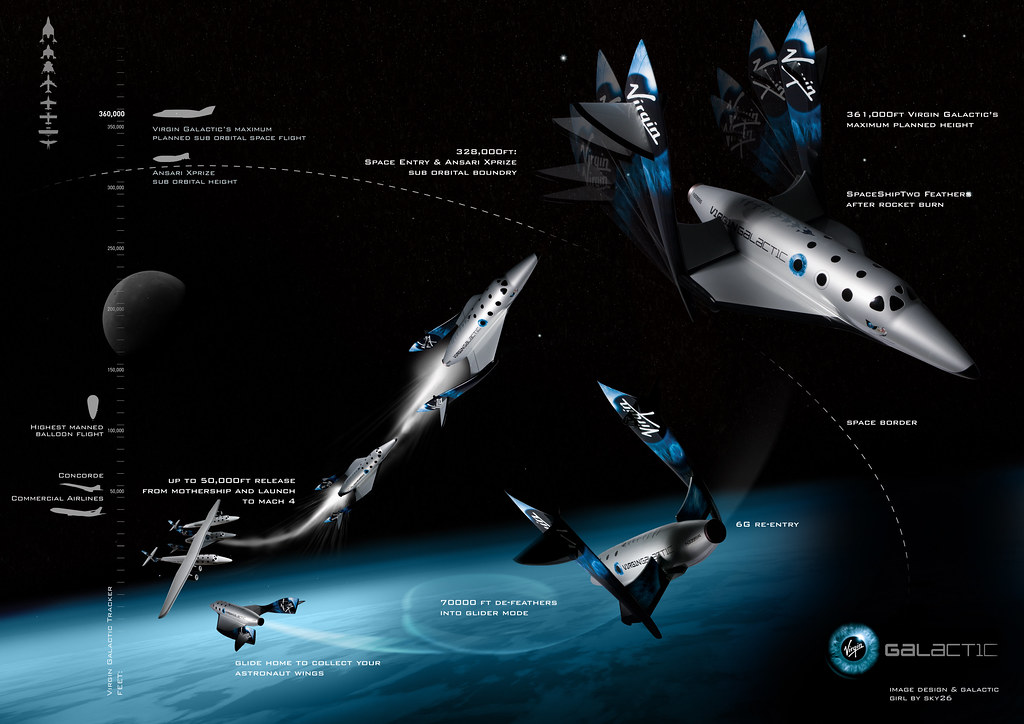
The impacts of space tourism extend beyond the personal excitement of space travel. Economically, it promises significant revenue and job creation while driving technological advancements that could benefit other industries. Public interest in space exploration is expected to increase, inspiring future generations of scientists and engineers. Additionally, efforts are underway to develop more sustainable technologies that mitigate the environmental impact of space tourism.
Despite its promise of fun (albeit with some significant risk) and spectacular views of the Earth, space tourism faces several challenges. The high cost of a seat to space remains a substantial barrier to broader accessibility, though advancements in technology and increased competition are expected to reduce prices over time. Ensuring the safety of space tourists is crucial, and it requires rigorous testing and the development of advanced safety approaches. Building the necessary infrastructure, including spaceports and support services, is essential for the successful expansion of space tourism. One has to wonder how long it will be before a trip to Disney World includes a suborbital ride into space!
Summary & Closure
Human ingenuity and innovation have overcome the engineering challenges of reaching space. The ability to successfully engineer rockets and spacecraft has enabled humans to put satellites into orbit, land on the Moon, send probes to study other planets, and accomplish many other feats. The history of space flight is a testament to humanity’s curiosity, scientific and engineering ingenuity, and perseverance. The launch of Sputnik 1 by the Soviet Union in 1957 marked the beginning of the “space race” between the Soviet Union and the United States, which led to rapid advancements in space technology. In 1961, Yuri Gagarin became the first human to orbit the Earth, followed closely by Alan Shepard’s suborbital flight aboard Freedom 7. The climax came in 1969 when the first humans set foot on the Moon during NASA’s Apollo 11 mission.
Following the Apollo program, space exploration expanded with the development of space stations like Skylab and Mir, paving the way for international cooperation in space, as exemplified by projects such as the International Space Station (ISS). Many space probes have provided invaluable insights into celestial bodies beyond the Earth and the solar system. These robotic explorers conduct scientific investigations, gathering data and sending back breathtaking images of distant planets, moons, and asteroids. Throughout history, space probes have played pivotal roles in expanding our understanding of the planets of the solar system and the universe at large. Iconic missions such as Voyager 1 and 2 have ventured far beyond the outer planets and into interstellar space.
Research activities in space have led to many new technologies that benefit everyone on Earth. The ability to launch satellites into low Earth orbits has provided a unique perspective on the Earth, including its weather and the impact humans have on the environment. Satellites enable rapid communication, and the NavStar GPS has been revolutionary, improving life on Earth. New space technologies, including reusable launch vehicles and more efficient rocket engines, have significantly reduced the cost of launching payloads into space, making space increasingly accessible.
With continued advancements in space technology, further exploration of the solar system and beyond is expected, with human missions back to the Moon being a crucial step toward this goal. In the coming decades, humankind will likely explore space like never before. Commercial space companies continue to develop technologies that make spaceflight more affordable and accessible, thereby revitalizing the public’s interest in space. The continued growth of the commercial space industry, including the development of space tourism, is also expected to drive scientific discovery and the possibilities of living and working in space.
5-Question Self-Assessment Quickquiz
For Further Thought or Discussion
- List some space research activities explored with the “X-planes” to the end of the 1950s.
- Discuss why a multi-stage launch vehicle might be better than a single-stage one.
- Who were the “Mercury Seven” astronauts? Which Mercury Seven astronaut would later walk on the Moon? Which astronaut would fly in the Space Shuttle?
- What are some challenges of returning humans to the Moon? To Mars? Hint: Not all challenges may be technical.
- What is a geosynchronous orbit? Discuss the challenges in putting a satellite into a geosynchronous orbit.
- Consider some engineering and cost trades in developing a reusable launch vehicle.
Additional Online Resources
To improve your understanding of space history, navigate to some of these online resources:
- To view an interactive timeline highlighting significant events in space exploration, visit In Space We Trust.
- A video about 25 mind-blowing facts about the Apollo space program.
- The History of Space Exploration by National Geographic.
- A Brief History of Space Exploration.
- 60 Years and Counting – A NASA Space History.
- A great video on the Space Shuttle, narrated by William Shatner.
- A NASA video on the journeys of the Apollo spacecraft.
- A super technical description and video about the Saturn F-1 engines.
- Learn about the fastest and most complex flying machine humankind has ever created, which has 2.5 million moving parts and is capable of 25 times the speed of sound!
- See a SpaceX launch of a Starlink batch, including the landing of the first stage.
- Non-technical challenges of reaching space include the high costs of development and launch, ensuring astronaut safety, and addressing the psychological and physical impacts of space travel. ↵
- The U.S. was not the only Allied nation doing this; Britain, France, and the Soviet Union had their own programs to exploit German scientific and engineering knowledge after WWII. ↵

